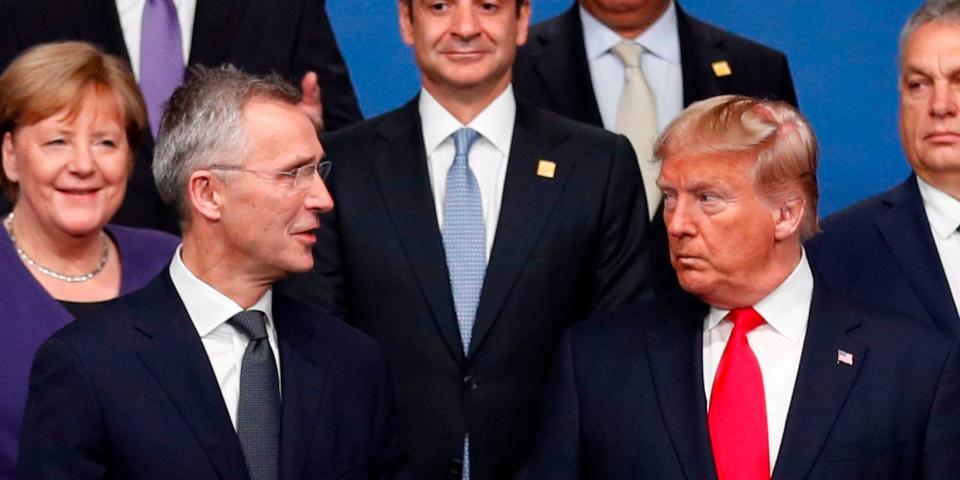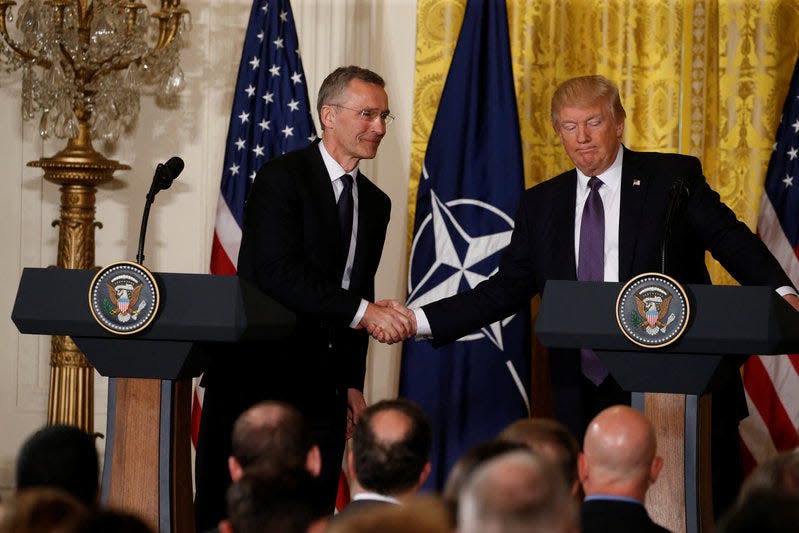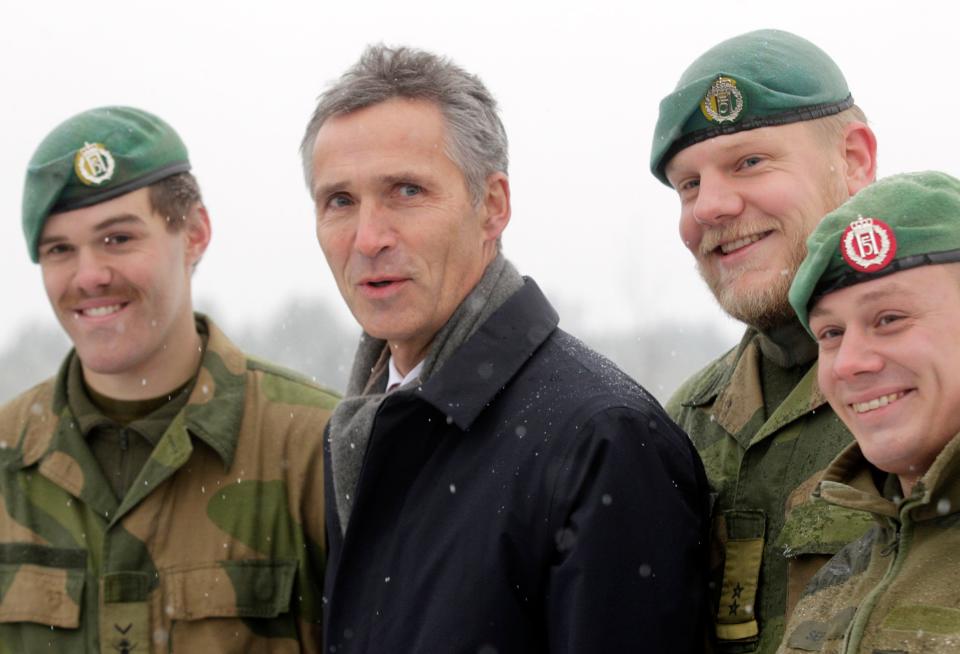How NATO leaders used quiet maneuvers and 'adroit flattery' to keep Trump from blowing up the alliance

Trump's complaints and criticism of NATO led officials to worry about his intentions for the alliance.
After he took office, NATO officials mounted a campaign of quiet maneuvers and public diplomacy to placate and distract him.
The alliance survived thanks largely to the skills of NATO Secretary General Jens Stoltenberg, new research shows.
The Trump presidency posed an existential threat to NATO and to transatlantic relations.
Before and during his time in office, former President Donald Trump questioned the necessity of NATO, complained about US spending on the alliance, and criticized the underinvestment of many NATO members.
Trump even seemed to threaten a US withdrawal from NATO if members didn't meet the alliance's 2%-of-GDP spending target.
Trump also wanted to restore relations between NATO and Russia, which other NATO members strongly opposed because of Russia's 2014 annexation of Crimea and its ongoing proxy conflict in Ukraine's Donbass region.
However, NATO managed to survive Trump thanks to the deft diplomacy and interpersonal skills of NATO Secretary General Jens Stoltenberg, according to research by Leonard Schuette of the University of Maastricht, who interviewed 23 senior NATO and member-state officials about Stoltenberg's central role in placating Trump and preserving the alliance.
A personal approach

The US was exhorting NATO allies to step up their defense spending even before Trump took office. In 2014, President Barack Obama said "everyone should chip in."
At the 2014 Wales Summit, NATO members formalized what had been a loose expenditure target by agreeing to spend 2% of their GDP on defense — 20% of that on new equipment — by 2024.
By the time Trump assumed the presidency, only five of NATO's 28 member-states, including the US, had met that target. Some of NATO's wealthiest members were well below the 2% threshold, including Germany, which became the focus of Trump's ire.
It fell to Jens Stoltenberg and his team to appease Trump and keep the alliance together.
Stoltenberg and senior NATO officials embraced "Trump's demands for greater burden-sharing" because "they promised to generate most goodwill with the U.S. president and were not harmful to the alliance," according to Schuette.
Stoltenberg lobbied allies to increase their defense spending. By making sure to do so publicly, Stoltenberg was able to put more pressure on underpaying members and to signal to Trump that he shared Trump's concerns.
To placate the unpredictable American president and cast him as the main driver of positive change within the alliance, Stoltenberg credited Trump with any success in securing spending commitments.
In May 2018, Stoltenberg visited the White House and, in a clever bit of public diplomacy, thanked Trump for his leadership. "It is impacting allies, because all allies are now increasing defense spending. They're adding billions to their budgets," Stoltenberg said.

Two months later, at NATO's London Summit, which some had feared would spell the alliance's end, Trump announced that "everyone has agreed to substantially up their commitment. They're going to up it at levels that they never thought of before."
Despite Trump's swagger, those increases were the result of efforts by Stoltenberg, who "strategically promoted the view that Trump had prevailed over opposition from other member states," Schuette writes.
Stoltenberg was also always careful to compare "the spending figures to 2016 — the year of Trump's election — rather than 2015, when the allies' budgets first showed increases," Schuette notes.
According to one official interviewed by Schuette, Stoltenberg would even present the increases in defense spending to Trump using "very simple bar charts" — playing to Trump's preference for visual aids.
After the London Summit, Stoltenberg continued his efforts. He praised Trump's push for increased expenditures in a Fox News interview while visiting the US in 2019, saying it had resulted in "an extra $100 billion allies would have added to their spending by 2020."
Stoltenberg's tactics paid off, even if they didn't bring all allies up to their spending commitment.
In 2019, only seven out of the then-29 allies met the 2% target and only 15 were planning to meet it by 2024.
Nevertheless, when asked that year if the US would withdraw from NATO, Trump replied, "People are paying and I'm very happy with the fact that they're paying."
The power of connections

The other major point of contention between Trump and NATO allies was Russia. Trump often praised Russia and its president, Vladimir Putin.
In this case, clever public diplomacy would not work, as NATO's approach to Russia "was a matter of concrete policy-making," says Schuette.
Stoltenberg relied on a different tactic to prevent rapprochement with Moscow and maintain NATO's deterrence posture in the face of Russian aggression, Schuette writes.
Firstly, in his interactions with Trump, Stoltenberg kept mentions of Russia to a minimum, instead focusing on burden-sharing to divert Trump's attention.
Secondly, Stoltenberg relied on US officials actually responsible for implementing foreign policy, including Congress, the National Security Council, the State Department, and the Pentagon.

Stoltenberg tapped into those circles "to coordinate policy and maintain US domestic support for the alliance," according to Schuette.
Stoltenberg was helped by his deputy, Rose Gottenmoeller who had previously been the under secretary of state for arms control and international security in the US State Department and whose connections to US policymakers proved vital.
In the end, NATO's posture toward Russia did not change, with the alliance maintaining its operational tempo in the east.
Amid these maneuvers, Stoltenberg managed to maintain a very good relationship with Trump, who often praised the secretary general and supported extending his term for two years.
As a senior official told Schuette, Stoltenberg "was the only one in Europe who had Trump's ear."
Constantine Atlamazoglou works on transatlantic and European security. He holds a master's degree on security studies and European affairs from the Fletcher School of Law and Diplomacy.
Read the original article on Business Insider

 Yahoo News
Yahoo News 